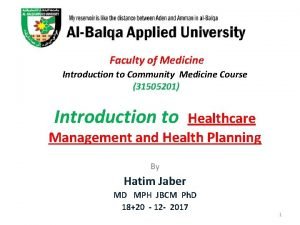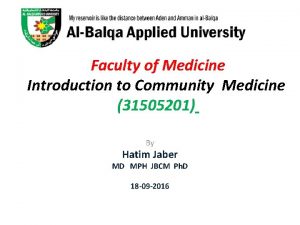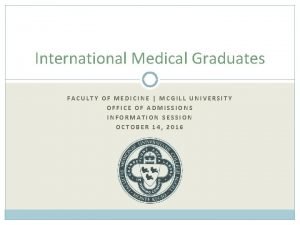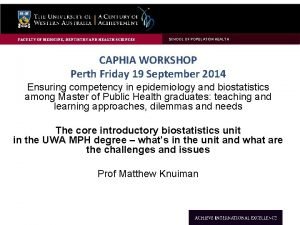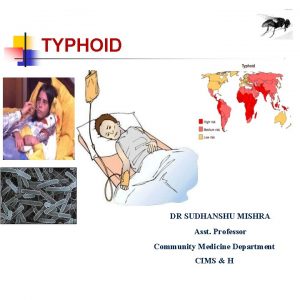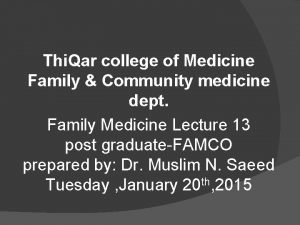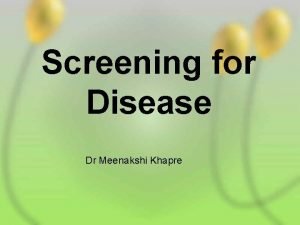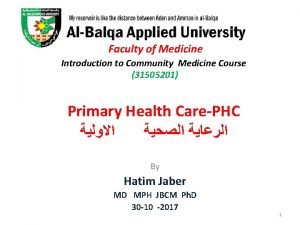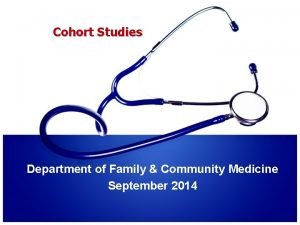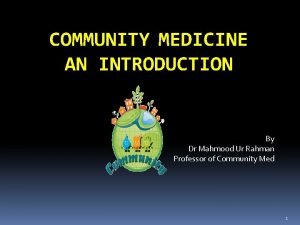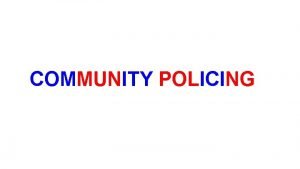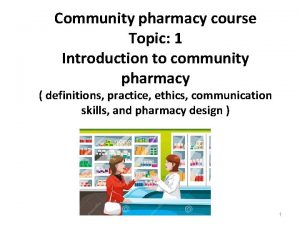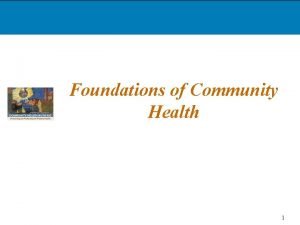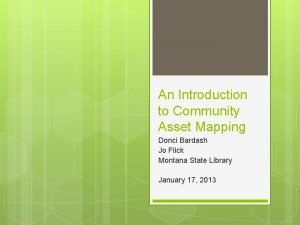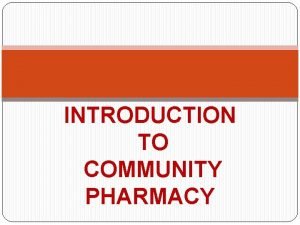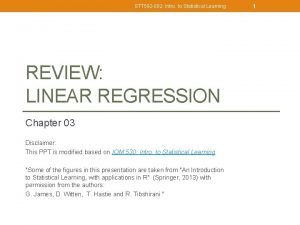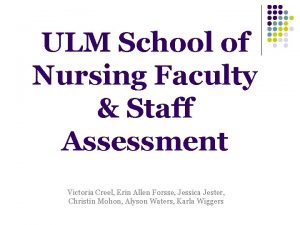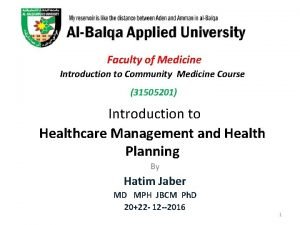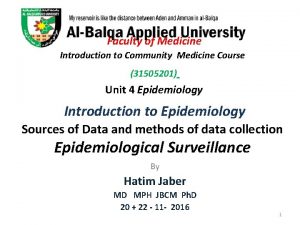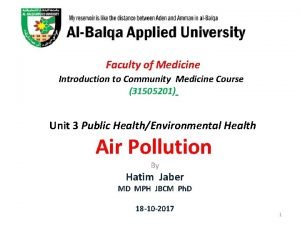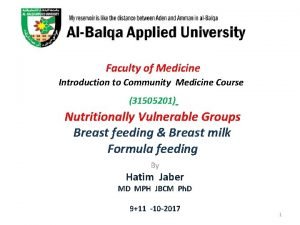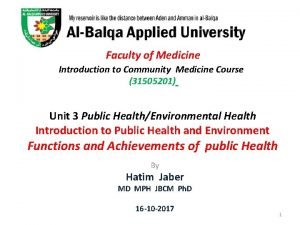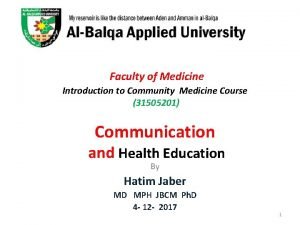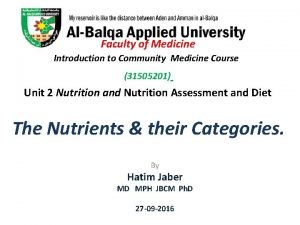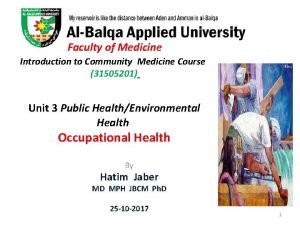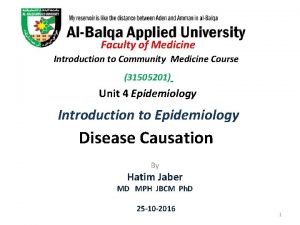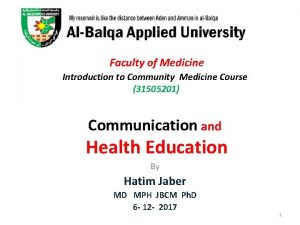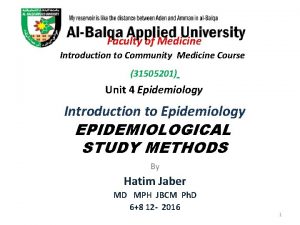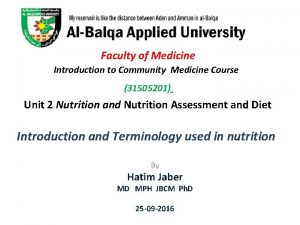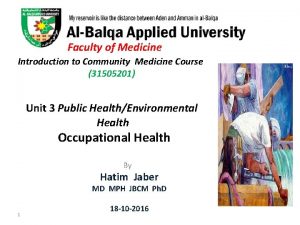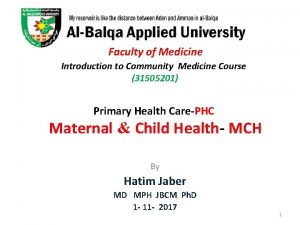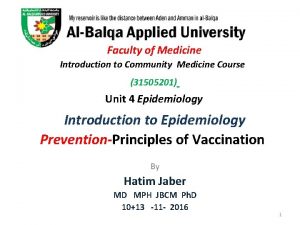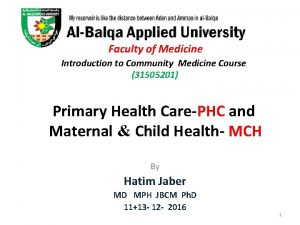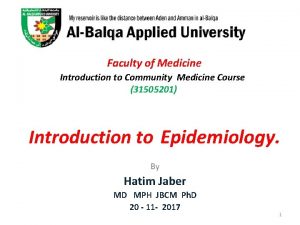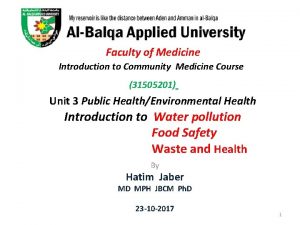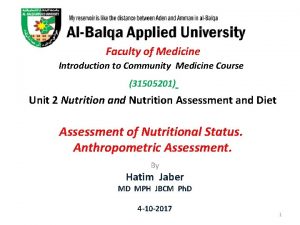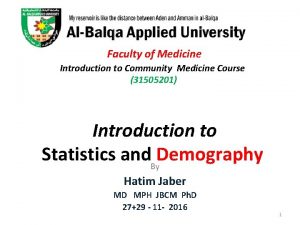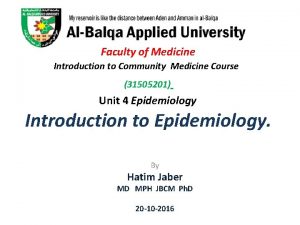Faculty of Medicine Introduction to Community Medicine Course























































































- Slides: 87

Faculty of Medicine Introduction to Community Medicine Course (31505201) Public Health Surveillance By Hatim Jaber MD MPH JBCM Ph. D 11 - 12 - 2017 1

• Number of people affected by dementia to triple in next 30 years 2

3

4

Post midterm • Week 8 Unit 6: Demography and Data • Week 9 Midterm assessment (Exams. )15 -11 -2017 Week 10 Unit 8 Introduction to Epidemiology. • Week 11 Unit 9: Prevention and Control of Diseases Causation • Week 12 Unit 10: Communication and Health Education • • • Week 13 Unit 11: Public Health Surveillance and Screening • Week 14 Unit 12: Health Administration and healthcare management • Week 15 Unit 13: Revision and Health Research • Week 16 Final assessment (Exams. ) 4 -1 -2018 5

Presentation outline Time Definitions of surveillance 08: 00 to 08: 15 Objectives of surveillance Public health vs health care surveillance 08: 15 to 08: 30 Elements of a surveillance system 08: 30 to 08: 45 Surveillance methods 08: 45 to 09: 00 Surveillance system in Jordan 09: 00 to 09: 15 6

Data Sources: Population § § Census Vital registration system Sample household surveys Special population surveys - Demographic (elderly, youth) - Risk groups ( IDUs) - Occupational (farmer, skilled labor) - Area-based (catastrophe-affected) § Biomarkers 7

Types of Information • Surveillance – Epidemiological – Behavioral • • Routine service reporting Special program reporting systems Administrative systems Vital registration systems Facility surveys Household surveys Censuses Research and special studies 8

“Surveillance” 9

The word “Surveillance” • The word "sur-veillance" means (in French) "to watch from above" ("veiller" = "to watch" and "sur" = above") (i. e. a God's-eye view looking down from on-high) • The term is often used for all forms of observation, not just visual observation. 10

Definition of Surveillance Public health surveillance (sometimes called epidemiological surveillance) is : the ongoing systematic collection, analysis, and interpretation of outcome-specific data essential to the planning, implementation, and evaluation of public health practice, closely integrated with timely dissemination of these data to those who need to know. Outcomes may include diseases, injury, and disability, as well as risk factors, vector exposures, environmental hazards, or other exposures. The final link of surveillance chain is the application of these data to prevent and control human diseases and injury. 11

Surveillance Principle Surveillance is: “Information for Action” “If you don't use it, then do not ask for it!” However: “Good surveillance does not necessarily ensure the making of the right decisions, but it reduces the chances of the wrong ones” A. D. Langmuir (1963) 12

History • In 1950, the term “surveillance” was restricted to public health practice to watching contacts of serious communicable diseases” – To early detect symptoms – To institute prompt treatment – Example: Smallpox 13

Surveillance, surveys, registries and HMIS: • Surveillance is systematic ongoing collection, collation, and analysis of data, and the timely dissemination of information to those who need to know so that action can be taken • A survey is a one data collection episode • Registries are not for immediate action • Health Management Information Systems (HMIS) for annual reports 14

Who Performs Public Health Surveillance? • • • Epidemiologists Medical professionals (doctors, nurses, clinics) Pharmacies Health insurance providers Emergency responders Public health departments (local, state, federal) • Surveillance provides the information for descriptive epidemiology, which is • Person (age, sex, description) • Place (where) • Time (dates, hours, days, months, years) 15

Note the Differences: • Registers are archival health information • Surveillance is dynamic as compared with surveys: Interplay between epidemiologic studies and control activities • Surveillance is not mere: – Reporting – Monitoring – Data collection 16

Continuous versus Periodic Data Collection Continuous Data Collection Periodic Collection Data Collection Small team Large team or multiple teams Data accessibility Initially slow Faster turnaround Data usefulness for Ongoing results trend analysis Results only after three rounds of data collection Evaluation of health intervention Continuous Timing of collection often monitoring of impact not linked to intervention Budget Line item in health budget One-off investment at each cycle 17

Public health vs health care surveillance • Public health – protection, promotion, and restoration of health of population – includes health care services, especially if publicly-funded • Health care – services provided to individuals or communities by agents of health services or professionals to promote, maintain, monitor, or restore health. Not limited to medical care (therapy by MD) 18

Public health vs health care surveillance (cont’d) • Health care surveillance – may be part of public health surveillance (e. g. , Montreal DSP) – also conducted by other agencies and/or health care organizations (e. g. , hospitals) • Population may differ – public health: usually defined geographically (district, region, country) – health care: recipients of services or catchment population 19

Goals and Uses of Surveillance • Detect outbreaks or epidemics – – Detect changes in trends over time, portray natural history of diseases Evaluate control measures – Making projections, understanding burden of disease and justifying allocation and or redirection of resources • Estimate magnitude of morbidity and mortality – Ensure equity in health care (mortality and morbidity) • Facilitate planning • Stimulate epidemiologic research – – 20 Generate/ Test hypotheses (e. g. changes in health practice) Identify risk factors (in-depth studies)

Objectives of Surveillance • Early detection and prediction of outbreaks • Description of the magnitude of disease • Understanding risk factors for diseases • Monitoring trends of endemic disease • Monitor programme performance and • progress towards a control objective Estimate future disease impact 21

Surveillance objectives Surveillance should be SMART. . . S - Specific (regarding event which is subject of ) M - Measurable (gain info for comparison ) A - Action oriented (information for action) R - Realistic & (feasible in time and place) T - Timely (action implemented in time to be effective) Setting objectives – balance between requirements and interests! 22

Added values of Surveillance • High-quality surveillance increases credibility of public health care providers: – – – 23 Encourages transparency Reduces over-reaction Attract donors Encourages implementation of new interventions; new conjugate meningococcal vaccines Facilitates better management of disease control and other public health programs SAVES LIVES !!!!

Importance of Good Reporting Health Care System Reporting Intervention 24 Data Analysis & Interpretation Evaluation Event Public Health Authority Feedback Information

Delayed Detection Means =Delayed Response Early Detection… • Early warning indicators: – Count of cases (? ) – Attack rates (stratified) – Case-fatality rates • Temporal component • Defined thresholds • Notification of cases – Suspect and probable – Case-based data – Immediate or weekly 25

Where Do We Get Public Health Surveillance Data? • Vital records – Hospital records, death certificates, birth records • Surveys – Schools, doctors, insurance companies • Environmental monitoring systems – Water or air quality • Animal health data – Veterinarians, farms, food manufacturing 26

Types of Surveillance Active vs. Passive Surveillance • Active Surveillance: Health department solicits reports • Passive Surveillance: Reports are initiated by source for data 27

• Passive surveillance; Routine surveillance where reports are awaited and no attempt make actively seek reports from the participants in the system. 28

Routine and sentinel surveillance • Sentinel surveillance; The surveillance of a specified health event in only sample of the population at risk using a sample of possible reporting sites. The sample should be representative of the total population at risk. • Passive surveillance; Routine surveillance where reports are awaited and no attempt make actively seek reports from the participants in the system. 29

30 Sentinel Surveillance • Often provides an early alert for outbreaks • Focal points: Clinics, hospitals or laboratories • • • Less sites but better quality of data bring attention to problems in practices, procedures or systems Useful for research activities – Most useful for diseases that occur frequently – Not intended to capture all cases – Strategic locations – Representative to population (socio-demographic) – High risk groups

• Aggregate surveillance; The surveillance of a disease or health event by collecting summary data on groups of cases (e. g. in many general practice surveillance schemes clinicians are asked to report the number of cases of a specified diseases seen over a period of time). 31

• Case-based surveillance; The surveillance of a disease by collecting specific data on each case (e. g. collecting details on each case of Acute Flaccid Paralysis in polio surveillance) • Cluster; The occurrence of an unusual number of cases in person, place 32

• Community surveillance; Surveillance where the starting point is a health event occurring in the community and reported by a community worker or actively sought by investigators. This may be particularly useful during an outbreak and where syndromic case definitions can be used. • Comprehensive surveillance; The surveillance of a specified disease or health event in the whole population at risk for that event. 33

• Enhanced surveillance; The collection of additional data on cases reported under routine surveillance. The routine surveillance is a starting point for more specific data collection on a given health event. This information may be sought from the reporter, the case, the laboratory or from another surveillance data set. • Intensified surveillance ; The upgrading from a passive to an active surveillance system for a specified reason and period (usually because of an outbreak). It must be noted that the system becomes more sensitive and secular trends may need to be interpreted carefully. 34

Syndromic Surveillance • Syndrome is a complex of symptoms • Syndrome is constellation of signs and symptoms! • Syndromic surveillance focuses on one symptom or constellation of symptoms (clinical outcomes) rather than a diagnosed disease • No need of laboratory confirmation. Hence fast. • More sensitive, but less specific • Faster public health interventions For Example – WHO ALERT system for early detection of outbreaks is syndromic S. SS is surveillance for AFP (syndrome, clinical outcomes) in order to capture possible cases of poliomyelitis. 35

Surveillance of Disease vs. Persons • Surveillance of Disease: “ The continuing scrutiny of all aspects of occurrence and spread of disease that are pertinent to its effective control” • Surveillance of Persons: “ The continuing scrutiny of disease contacts, high risk groups in order to promote prompt recognition of infection or illness” 36

Elements of a surveillance system • Case definition • • • Indicators Population under surveillance Cycle of surveillance Confidentiality Incentives to participation 37

• Case definition; A set of diagnostic criteria that must be fulfilled to be regarded as a case of a particular disease. • Case definitions can be based on clinical criteria, laboratory criteria or a combination of the two. • A case definition is a set of criteria that triggers reporting 38

Elements of surveillance system: case definition • Requirements – – – Indicator (not diagnostic) of trends Simple Feasible Reliable Inexpensive • Examples – Measles: fever with red rash, red eyes, disappearing within a week – Cholera: Sudden and severe watery diarrhoea, with rapid and massive dehydration – Malaria: Fever, rigors, headache, body aches, inability to carry out normal daily activities 39

Case definition ü YES - A “case” is an event NO - A “case” is not a person - An event is something that - Events do not exist if you happens to: lack info: • A person, o On the person • In a given place, o On the place • At a given time o On the onset date - A case definition is a set of criteria that triggers reporting - A case definition is not a diagnosis made to decide treatment 40

Case definition Includes: Should be: Time, place, person. Clear, simple Clinical features Field tested and /or Stable and valid Laboratory results Adopted and/or Epidemiological features 41

Case definition--three-level definitions Meningococcal disease (SURVEILLANCE PURPOSES) Possible case Clinical diagnosis of meningitis or septicaemia or other invasive disease where the consultation with the clinician and microbiologist, considers that diagnoses other than meningococcal disease are at least as likely Probable case Clinical diagnosis of meningitis or septicaemia or other invasive disease where the consultation with the physician and microbiologist, considers that meningococcal infection is the most likely diagnosis Confirmed case Clinical diagnosis of meningitis, septicaemia or other invasive disease AND at least one of: • Neisseria meningitidis isolated from normally sterile site • Gram negative diplococci in normally sterile site • Meningococcal DNA in normally sterile site • Meningococcal antigen in blood, CSF or urine. 42

Elements of surveillance system: population under surveillance • Population-based • Institution-based – hospitals, practices, nursing homes, prisons, schools • Combinations – e. g. , Drug Abuse Warning Network (DAWN) in US: morbidity and mortality data on illicit drug use from hospital ERs and medical examiners/coroners 43

Elements of surveillance system: cycle of surveillance • • • Occurrence of health event Detection by health care provider Notification of health agency Analysis and interpretation Dissemination 44

Elements of surveillance system: confidentiality • Legally mandated reporting requires confidentiality precautions – limited access to data (locks, passwords etc) – encryption algorithms for coding names • Perceived lack of confidentiality a major deterrent to completeness of reporting – STDs – drug use 45

Surveillance methods • • Active vs passive methods Legally notifiable diseases Sentinel events Sentinel surveillance • Cross-sectional vs longitudinal 46

Surveillance methods: longitudinal vs cross-sectional • Longitudinal – Ongoing data collection – Incident cases – Examples: notifiable diseases, vital statistics, disease registries • Cross-sectional – Serial surveys 47

Levels of Surveillance • National: – Periphery: (e. g. , PHCC catchment area, city) – Intermediate: Provincial – Central • International: – International Health Regulations 2005 48

Special Surveillance Programs • Natural and man-made disasters (emergencies) • During Special events of mass gatherings – – (Pilgrims to Makkah Olympics – – Emerging pathogens Antimicrobial resistance • Laboratory-based surveillance: • Infection control • Behavioural risk factors • Others 49

Systems of Disease Surveillance • Notifiable disease reporting systems • Laboratory-based surveillance • Hospital-based surveillance • Population-based surveillance • Vital records (birth and death certificates) • Registries 50

DEFINITIONS • Disease notification is a process of reporting the occurrence of disease or other healthrelated conditions to appropriate and designated authorities. • A notifiable disease is any disease that is required by law to be reported to government authorities. 51

• A notifiable disease is one for which regular, frequent, and timely information regarding individual cases is considered necessary for the prevention and control of the disease. • Physicians are required by law to report cases of certain infectious diseases. Unfortunately, many do not. 52

Surveillance Definitions • Active case-finding; The dynamic identification of the occurrence of a disease or health event under surveillance. (e. g. house visits by community workers to identify cases of tuberculosis). • Active surveillance; Routine surveillance where reports are sought dynamically from participants in the surveillance system on a regular basis (e. g. telephoning each participant monthly to ask about new cases). 53

• Surveillance sensitivity; The ability of a surveillance system to detect an outbreak. (The proportion of all outbreaks that could have been detected by the system). • Surveillance predictive value; The likelihood that an “outbreak” detected by a surveillance system is truly an outbreak 54

• Survey; An investigation in which information is systematically collected. It is usually carried out in a sample of a defined population group and in a defined time period. Unlike surveillance it is not ongoing though it may be repeated. If repeated regularly surveys can form the basis of a surveillance system. • Zero reporting ; The reporting of zero cases when no cases have been detected by the participant. This allows the next level of the system to be sure that the participant has not sent data that has been lost or has forgotten to report. 55

The following should be addressed for each disease under surveillance: • is the case definition: - clear? appropriate? consistent throughout the surveillance system? • is the reporting mechanism: clear ? efficient? of appropriate reporting periodicity? available to all relevant persons and institutions? • is the analysis of data : appropriate? susceptible to proper presentation? used for decision-making? 56

• do the personnel involved: have a good understanding of the value of the surveillance system? understand, show interest in, and support, their own surveillance task? have enough appropriate human and material resources? • do the personnel involved receive appropriate: training? supervision? • is the feed-back from intermediate and central levels: appropriate? sufficient? motivating? • When the assessment of current activities is done, the next question is: · Is there an operational control program for each of the priority diseases? 57

Reporting Channels 58

CHAIN OF REPORTING HCP DNO LG MOH WHO/CDC FMOH SMOH Key: HCP: Health care providers DNO: Disease notification officer LG MOH: Local Government Medical Officer of Health SMOH: State Ministry of Health FMOH: Federal Ministry of Health 59

Notification • A notification is the reporting of certain diseases or other healthrelated conditions by a specific group, as specified by law, regulation, or agreement. • Notifications are typically made to the state or local health agency. 60

Integrated Disease Surveillance and Response (IDSR) • IDSR form 001: For immediate/case based reporting of diseases. • Immediate reporting allows for timely action to be taken to prevent the re-emergence or rapid transmission of epidemic prone diseases or events, especially diseases due to highly pathogenic and lethal infectious. 61

Diseases/Events reported with form IDSR 001 list of diseases/events requiring immediate reporting. • Acute Flaccid • Paralysis (AFP) • • Acute hemorrhagic fever syndrome • (Ebola, Marburg, Lassa • Fever, RVF, Crimean-Congo) • • Adverse event • following • immunization (AEFI) • Anthrax • Chikungunya • Cholera Cluster of SARI Diarrhoea with blood (Shigella) Dracunculiasis Influenza due to new subtype Maternal death Measles Meningococcal meningitis • Neonatal tetanus • Plague • Rabies (confirmed cases) SARS Smallpox Typhoid fever Yellow fever Any public health event of international concern (infectious, zoonotic, food borne, chemical, radio nuclear or due to an unknown condition) • • • 62

• IDSR form 002: For weekly reporting of new cases of epidemic/pandemic prone diseases. • IDSR form 003: For routine monthly notification of other diseases of public health importance. Integrated Disease Surveillance and Response (IDSR) 63

Diseases that require monthly reporting • • • Acute viral hepatitis • AIDS (New Cases) • • Buruli ulcer Diabetes mellitus • Diarrhoea with severe dehydration in children under 5 • years of age • HIV (new detections) • Hypertension • Influenza-like illness Injuries (Road Traffic Accidents) Leprosy (quarterly) Lymphatic Filariasis Malaria Malnutrition in children under 5 years Mental health (Epilepsy) Noma Onchocerciasis Severe pneumonia in children under 5 years of age • Sexually transmitted diseases (STIs) • Trachoma • Trypanosomiasis • Tuberculosis (quarterly) • Underweight Newborns (less than 2500 g) 64

Reportable Diseases • Vary from one country to another – Differences within countries – Changes over time • Adding one single disease to the list could cost • • 65 a lot: Money, time, avoidable confusion Variables collected should be indicators of potential or arising problems rather than identifying risk factors Report only confirmed cases?

Frequency of Reporting Diseases • Weekly? Appropriate most times • Monthly? Less sensitive • Quarterly? At national level • Daily? – Daily reporting could be cumbersome – Daily reporting may be required during emergencies, disasters • Avoid inconsistencies in case definitions • Reporting suspected vs. confirmed cases 66

Data Collection Forms • Should be (for line-listing): – Simple – Minimum content – Layout easy to understand – Easy to reproduce • Special data collection forms: –Special surveillance programs (e. g. , Malaria, vector control) – During outbreaks (Locally acquired or imported? ) – Eradication activities 67

Public Health Laboratories • Fully linked to epidemiological surveillance • Ability to confirm diagnosis of epidemic – prone • diseases of national interest Monitor and report selected pathogens – Meningococcal meningitis and other bacterial meningitis – Cholera, Shigellosis and salmonellosis – Viral Hemorrhagic fevers, etc • Monitor antimicrobial resistance 68

Information Loop of Public Health Surveillance Public Reports Summaries, Interpretations, Recommendations Health Care Providers Health Agencies Analysis 69

Essential activities of surveillance 1. Identify; define and measure the health problem of interest; 2. Collect and compile data about the problem (and if possible, factors that influence it) 3. Analyze and interpret these data 4. Provide these data and their interpretation to those responsible for controlling the health problem and 5. Monitor and periodically evaluate the usefulness and quality of surveillance to improve it for future use. N. B surveillance of a problem does not include actions to control the problem. 70

Key Indicators • Absolute numbers • Proportions • Rates • Percentages • Threshold 71

Information Management 72

Evaluation of Surveillance Systems 73

Goals of Evaluation of Surveillance • To improve existing surveillance systems • To modify systems because of changes in – Priorities – Epidemiology – Diagnostics • To optimize the use of available resources 74

International Health Regulations 2005 • Current: Notification to WHO of a case of cholera, plague or yellow fever • IHR 2005 – – – 75 Public health emergencies of international importance Obligation to establish core capacities Assistance to States Context specific & flexible recommended measures External advice (emergency and review committees) regarding IHR

National Notifiable Disease Surveillance • Reporting mandated by state law/regulation • Health care providers, laboratories report to local HD (county) • County HD submits reports to State • Reports transmitted to CDC primarily through National Electronic Telecommunications System for Surveillance (NETSS) 76

Map of 54 clinics that participated in the public health surveillance project between May – December 2014 (indicated by red dots) 77

Mortality surveillance 78

Influenza: laboratory surveillance 79

500 United States, 1963 -1998 Vaccine MEASLES — by year, United licensed States, 1983– 1998 450 30 400 Reported Cases (Thousands) Evaluate control measures of MEASLES 25 350 20 300 20 15 250 10 200 10 5 0 150 1983 1988 100 1993 1998 Year 50 0 1963 1968 1973 1978 1983 Year 1988 1993 1998 80

Table of diseases, conditions and events reported in the public health surveillance project 81

Table of diseases, conditions and events reported in the public health surveillance project 82

Proportional morbidity of reported communicable disease cases, excluding acute diarrhoea and chicken pox, through the public health surveillance system between May – December 2014 83

84

Figure 5. 7 Reported Cases of Salmonellosis per 100, 000 Population, By Year — United States, 1972– 2002 Figure 5. 8 Reported Cases of AIDS, by Year — United States* and U. S. Territories, 1982– 2002 Source: Centers for Disease Control and Prevention. Summary of notifiable diseases–United States, 2002. Published April 30, 2004, for MMWR 2002; 51(No. 53): p. 59. • Total number of AIDS cases includes all cases reported to CDC as of December 31, 2002. Total includes cases among residents in the U. S. territories and 94 cases among persons with unknown state of residence. Source: Centers for Disease Conrol and Prevention. Summary of notifiable diseases–United States, 2002. Published April 30, 2004, for MMWR 2002; 51(No. 53): p. 59. 85

Measles/rubella incidence in Macedonia and immunization schedule changes in the period 1967 -1997 600 1972 M vaccine (13 months) Measles 500 Rubella 1983 МMR vaccine (13 months) 400 МB/100. 000 1987 М revaccine (7 years) R revaccine (14 years 1997 МMR revaccine (7 years) 300 200 100 07 20 05 20 03 20 01 20 99 19 97 19 95 19 93 19 91 19 89 19 87 19 85 19 83 19 81 19 79 19 77 19 75 19 73 19 71 19 69 19 19 67 0 86

Remember…. Surveillance is information for action! 87
 Introduction to community medicine
Introduction to community medicine Introduction to community medicine
Introduction to community medicine Hubert kairuki memorial university faculty of medicine
Hubert kairuki memorial university faculty of medicine Hyperparathyreosis
Hyperparathyreosis Mrbs scholarship
Mrbs scholarship King abdulaziz university faculty of medicine
King abdulaziz university faculty of medicine Agnes csaki semmelweis
Agnes csaki semmelweis Faculty of veterinary medicine cairo university logo
Faculty of veterinary medicine cairo university logo Hacettepe university faculty of medicine
Hacettepe university faculty of medicine Dorsocranially
Dorsocranially Semmelweis university faculty of medicine
Semmelweis university faculty of medicine Faculty of medicine mcgill
Faculty of medicine mcgill Faculty of veterinary medicine cairo university
Faculty of veterinary medicine cairo university Faculty of medicine dentistry and health sciences
Faculty of medicine dentistry and health sciences Emory dermatology clinic
Emory dermatology clinic Cairo university faculty of veterinary medicine
Cairo university faculty of veterinary medicine Faculty introduction speech
Faculty introduction speech How to install a lintel in a single brick wall
How to install a lintel in a single brick wall Course number and title
Course number and title Course interne course externe
Course interne course externe Drinking water
Drinking water Lead time in community medicine
Lead time in community medicine Types of family in community medicine
Types of family in community medicine Lead time in community medicine
Lead time in community medicine Kashif rahim
Kashif rahim Principles of primary health care
Principles of primary health care Cohort study community medicine
Cohort study community medicine Duke medicine grand rounds
Duke medicine grand rounds Seqs community medicine
Seqs community medicine Community action cycle for community mobilization
Community action cycle for community mobilization Introduction to banking course
Introduction to banking course Imbe introduction course v2
Imbe introduction course v2 Software engineering 1 course outline
Software engineering 1 course outline Pied piping
Pied piping Cleft sentences examples
Cleft sentences examples Ron had a course introduction
Ron had a course introduction Introduction to forensic medicine
Introduction to forensic medicine Introduction of community policing
Introduction of community policing Introduction to community pharmacy
Introduction to community pharmacy Introduction of community health nursing
Introduction of community health nursing An introduction to community asset mapping
An introduction to community asset mapping An introduction to community asset mapping
An introduction to community asset mapping Introduction to community pharmacy
Introduction to community pharmacy Herszon kherson maritime college of merchant marine fleet
Herszon kherson maritime college of merchant marine fleet University of bridgeport engineering
University of bridgeport engineering University of bridgeport computer science faculty
University of bridgeport computer science faculty Alamo colleges faculty salary schedule
Alamo colleges faculty salary schedule Hahnville high school powerschool
Hahnville high school powerschool Importance of faculty in higher education
Importance of faculty in higher education Http://www-bcf.usc.edu/~gareth/isl/advertising.csv
Http://www-bcf.usc.edu/~gareth/isl/advertising.csv Penn state neurosurgery faculty
Penn state neurosurgery faculty Mercy faculty forward
Mercy faculty forward Lee kong chian faculty of engineering and science
Lee kong chian faculty of engineering and science Carelli
Carelli Fsu cybersecurity major
Fsu cybersecurity major Mendel university faculty of business and economics
Mendel university faculty of business and economics Umd ee
Umd ee Factors influencing faculty staff relationship
Factors influencing faculty staff relationship Nit calicut chemistry
Nit calicut chemistry Czech technical university in prague civil engineering
Czech technical university in prague civil engineering Faculty 180 ecu
Faculty 180 ecu Faculty of engineering shoubra
Faculty of engineering shoubra Singularity executive program
Singularity executive program Faculty of law maastricht
Faculty of law maastricht Medical faculty in novi sad dean
Medical faculty in novi sad dean Umn faculty dental clinic
Umn faculty dental clinic Sjsu faculty affairs
Sjsu faculty affairs Unlv faculty senate
Unlv faculty senate Ulm nursing faculty
Ulm nursing faculty Personal tutor ucl
Personal tutor ucl Scdl student login
Scdl student login Training and development process
Training and development process Https://faculty.washington.edu/chudler/stm0.html
Https://faculty.washington.edu/chudler/stm0.html Parson kutztown
Parson kutztown Student faculty ratio for nba
Student faculty ratio for nba Kfupm faculty housing pictures
Kfupm faculty housing pictures Ascaris lumbricoides ova
Ascaris lumbricoides ova Faculty model of training
Faculty model of training Jeyakesavan veerasamy
Jeyakesavan veerasamy Fulbright faculty development program
Fulbright faculty development program Faculty of engineering university of porto
Faculty of engineering university of porto Faculty of organizational sciences
Faculty of organizational sciences Webkredit cuni
Webkredit cuni Electrotechnical faculty belgrade
Electrotechnical faculty belgrade Faculty of economics and business debrecen
Faculty of economics and business debrecen Dmse
Dmse Electrical engineering kfupm
Electrical engineering kfupm Faculty model of training
Faculty model of training
